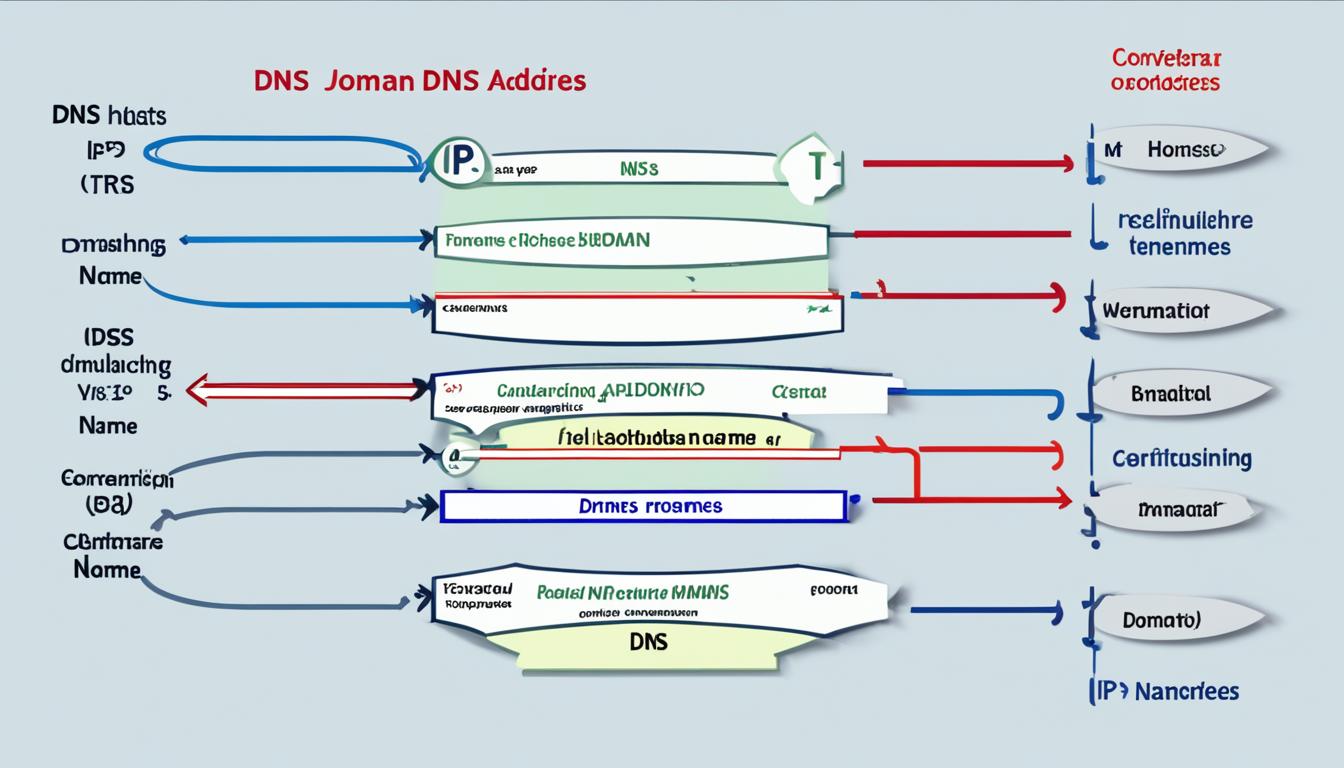Dns vs nameserver
Did you know that there are over 351.8 million registered domain names worldwide?
With the ever-expanding digital landscape, the domain name system (DNS) and nameservers play a crucial role in web hosting and website management. Understanding their differences can empower you to make informed decisions when it comes to your online presence.
Key Takeaways:
- DNS translates domain names into IP addresses, while nameservers connect domain names with the IP addresses of hosting servers.
- Managing nameservers and DNS records can be done through your web hosting account or domain registrar.
- DNS propagation is the process that allows changes to propagate across the internet, affecting website availability.
- Choosing the right solution between DNS and nameservers depends on your specific website management needs, such as website migration or domain registration.
- Regular monitoring of DNS records is important during changes to ensure proper website accessibility.
What is DNS and How Does it Work?
DNS, or the Domain Name System, is a fundamental protocol in the world of the internet. It acts as a phone directory, allowing users to easily browse websites by typing in user-friendly URLs instead of complex numerical IP addresses. In simpler terms, DNS converts domain names into IP addresses, which are essential for identifying and accessing websites on the network.
When you enter a URL like www.example.com into your browser, DNS comes into play. The browser uses the DNS system to locate the corresponding IP address associated with the domain name. Once the IP address is retrieved, it enables the browser to establish a connection with the website’s server and load the requested web pages.
Understanding the process of DNS is crucial for anyone who navigates the vast online landscape. The DNS system consists of a hierarchy of servers that work together to provide accurate and reliable name resolution. Each server in the hierarchy is responsible for specific domains or zones, ensuring seamless name resolution across the internet.
The DNS Resolution Process:
- The browser sends a request to the DNS resolver, typically provided by the user’s internet service provider (ISP).
- The DNS resolver then looks up the requested domain name within its local cache. If the IP address is found, the resolver immediately returns the corresponding IP address to the browser.
- If the requested IP address is not cached, the resolver queries the root DNS servers, which hold the information of top-level domains like .com, .net, or country-specific domains like .ca for Canada.
- Based on the top-level domain, the resolver is redirected to the appropriate authoritative DNS server.
- The authoritative DNS server provides the IP address associated with the requested domain name.
- The resolver caches the IP address for future use and returns it to the browser.
- The browser establishes a connection with the web server using the IP address, enabling the website to be loaded and displayed.
The DNS resolution process happens within milliseconds, allowing users to seamlessly browse the internet without having to remember or enter complicated IP addresses. This crucial protocol simplifies website browsing and ensures a smooth user experience across the vast online landscape.
| DNS Components | Function |
|---|---|
| Root DNS Servers | Hold information about the top-level domains and direct resolvers to the appropriate authoritative DNS servers. |
| Authoritative DNS Servers | Store and provide DNS records, including IP addresses, for specific domains or zones. |
| Recursive DNS Resolvers | Respond to user’s DNS queries and perform the necessary lookups to provide accurate IP addresses. |
| DNS Caching | Temporary storage of DNS information to improve efficiency and reduce network traffic. |
Understanding Nameservers and Their Role in Website Accessibility
Nameservers are an integral component of the Domain Name System (DNS) and play a crucial role in ensuring website accessibility. They act as the bridge between domain names and the IP addresses of servers that host websites. When you enter a website URL into your browser, the nameserver provides the necessary information for the browser to locate and display the website.
Nameservers are stored in the DNS records of a domain, which are generated during the domain registration process with a web hosting provider or domain registrar. These records contain essential information that directs internet traffic to the correct server for a specific domain.
To illustrate how nameservers work, let’s consider an analogy. Imagine you are planning to visit a friend’s house in a new city. You know your friend’s name (the domain name) and want to reach their house (the website). However, without the address (the IP address) and a guidance system (the nameserver), it would be challenging to find their exact location.
Similarly, when you enter a domain name in a browser, it sends a request to the nameserver associated with that domain. The nameserver then responds with the IP address where the website is hosted. Once the browser obtains the IP address, it can establish a connection and retrieve the website’s content, making it accessible to you.
Choosing the right nameservers and maintaining accurate DNS records are essential for maintaining website accessibility. It ensures that visitors can access your website without any disruption and offers a seamless browsing experience.
How to Use Nameservers and Manage DNS Records
Managing nameservers and DNS records is essential for effective website management. Whether you want to update your nameservers or modify your DNS records, you can conveniently access the required tools through your web hosting account or domain registrar.
If your website is hosted by a web hosting provider, you can easily manage your nameservers by following these steps:
- Login to your web hosting account using your credentials.
- Navigate to the domain management section.
- Locate the nameservers settings.
- Make the necessary changes to your nameservers.
- Save the changes and wait for the DNS propagation to complete.
Alternatively, if your domain is registered with a different company, you’ll need to log in to your account with the domain registrar to manage your nameservers. The process may vary depending on the domain registrar, but generally, you should be able to find the nameserver management section in your account dashboard.
Along with managing nameservers, you can also modify your DNS records through the DNS management tools provided by your hosting provider or domain registrar. These tools allow you to configure various DNS records such as A records, CNAME records, MX records, and more. To update your DNS records, follow the steps below:
- Log in to your web hosting account or domain registrar account.
- Go to the DNS management section.
- Locate the DNS records associated with your domain.
- Edit or add new records as needed.
- Save your changes and allow time for DNS propagation.
By effectively managing your nameservers and DNS records, you can ensure smooth website accessibility and optimal performance. Now, let’s take a look at a table summarizing the key steps to manage nameservers and DNS records:
| Action | Process |
|---|---|
| Managing Nameservers | Login to your web hosting account or domain registrar account. Navigate to the nameservers or DNS settings section. Update the nameservers with the correct values. Save the changes and wait for DNS propagation. |
| Modifying DNS Records | Login to your web hosting account or domain registrar account. Access the DNS management tools. Locate the DNS records associated with your domain. Edit or add new records as required. Save the changes and allow time for DNS propagation. |

By following these steps and leveraging the provided tools, you can easily manage your nameservers and DNS records, empowering you to take full control of your website’s functionality and accessibility.
The Importance of DNS Propagation and Monitoring
When you make changes to your nameservers or DNS records, it takes time for the changes to propagate across the internet. This process, known as DNS propagation, can take up to 72 hours. It is important to monitor the status of your DNS records during this time to ensure proper website availability. Tools like a DNS checker can help you monitor the progress of DNS propagation and identify any issues.
DNS propagation is the time it takes for the updated DNS information to be distributed and cached by DNS servers around the world. During this period, some users may see the old DNS information, while others see the updated information. This can lead to inconsistencies in website accessibility.
Monitoring DNS propagation is crucial to keep track of the progress and ensure that your website is accessible to all users. A DNS checker tool allows you to verify if the changes you made to your DNS records have propagated successfully.
With a DNS checker, you can check the status of your DNS propagation by entering your domain name. It will provide information on the current IP addresses associated with your domain and indicate whether the DNS changes have fully propagated. This helps you identify any potential issues that may arise during the propagation process.
By regularly monitoring DNS propagation, you can ensure that your website is available to visitors and prevent any disruptions in website accessibility. It allows you to troubleshoot and resolve any DNS-related issues promptly, ensuring a seamless browsing experience for your users.

Monitoring DNS propagation is especially important when you are migrating your website to a new hosting provider, changing IP addresses, or updating DNS records. It allows you to assess the progress of the propagation and make any necessary adjustments to ensure a smooth transition.
In conclusion, DNS propagation plays a crucial role in website availability, and monitoring its progress is essential for effective website management. By using a DNS checker tool and staying vigilant during the propagation period, you can ensure that your DNS changes are successfully implemented and your website remains accessible to all users.
DNS vs Nameserver: Choosing the Right Solution for Effective Website Management
When it comes to website management, understanding the differences between DNS and nameservers is essential. DNS, or the Domain Name System, is responsible for translating domain names into IP addresses. On the other hand, nameservers connect the domain name with the IP address of the server hosting the website.
Whether you are migrating a website, registering a new domain, or considering a new web hosting provider, choosing the right solution is crucial. DNS plays a critical role in website accessibility and browsing. By ensuring that your DNS records are correctly configured, you can ensure that visitors can easily find and access your website.
For seamless website migration, it is important to consider both DNS and nameservers. When transferring your website to a new server or hosting provider, you need to ensure that your DNS records and nameserver information are correctly updated. This ensures that your website remains accessible during and after the migration process.
When registering a new domain, it is important to choose a reputable domain registrar that offers reliable DNS management services. This ensures that your domain is correctly linked to the appropriate nameservers and that your website remains accessible to visitors. Additionally, collaborating with a trusted web hosting provider can simplify website management by offering integrated DNS and nameserver management tools.
FAQ
What is DNS and how does it work?
What is the role of nameservers in website accessibility?
How do I use nameservers and manage DNS records?
What is DNS propagation and why is it important?
How do I choose the right solution for effective website management?
- Shop for Server & Workstation Systems & more - February 25, 2025
- IP Geolocation API and IP Location Lookup Tools - February 24, 2025
- What is GoDaddy? Everything You Need to Know in 2024 - February 23, 2025




















Post Comment
You must be logged in to post a comment.